Voith has Gravitas: Class 265 (Voith Gravita 15L BB) diesel shunter from Brawa
Evening all!
I need to admit that for a long time, my locomotive inventory has had a total lack of shunters – though there has been one attractive option which I'd been eyeing for a while. So, tonight, let us have a look at the Voith Gravita diesel-hydraulic shunter as produced by Brawa.
The Voith company, headquartered in the town of Heidenheim in the east of Baden-Württemberg, has its roots in the mid-19th century, but has proceeded to evolve into a full locomotive builder in recent years only.
The company branch now known as Voith Turbo had been producing hydraulic power transmissions and drivetrains for other loco builders such as MaK since the 1930s, culminating in the development of the LS 640 reU2 drivetrain in the 1990s. This drivetrain was expected to form the basis for a new generation of mainline diesel-hydraulics to replace older classes from the Bundesbahn and Reichsbahn era, especially with the prospect of an expected traffic upturn following German unification. However, newly formed Deutsche Bahn now had numerous powerful ex-Deutsche Reichsbahn diesels at their disposal, with the class 232 Co‘Co‘ diesel-electrics and their derivatives satisfying the requirement for a heavy mainline diesel for passenger and freight work. As private TOCs were fairly few in number at the time and often able to satisfy their own motive power requirements with second-hand locomotives, no other orders for a newly developed diesel-hydraulic took place at the time.
However, this situation had changed by the beginning of the 21st century, leading Voith to establish their own locomotive works and begin development of two new loco families on the basis of the broad range of transmissions and other components they had been developing for other loco builders in the past. The Voith locomotive works are located in Kiel, already known as the home of the equally famous Maschinenbau Kiel (MaK) enterprise which is now part of the Vossloh company.
In 2006, Voith presented their prototype for the Maxima family, which is now marketed as a high-power, modular mainline diesel-hydraulic capable of being adapted to different operating profiles.
In 2008, Voith then followed up with a new series of centre cab diesel-hydraulic shunters and light freight locomotives based on the same general technical layout, called the Gravita. Like the Maxima, this type was explicitly offered in various different configurations for operational profiles covering industrial shunting, yard shunting and short- to medium-distance trip freight workings.
While the number of Maximas remained fairly low during its first production cycle, the Gravita was well received by various customers. Most prominently, DB Schenker, intending to renew their inventory of diesel shunters and to replace the ageing V 90 series of B’B’ configured diesel-hydraulic shunters inherited from Deutsche Bundesbahn, ordered a total of 109 Gravita 10 BB locomotives – designated class 260 and 261 but not to be confused with the much earlier 260s and 261s from the Deutsche Bundesbahn V 60 series of C-coupled shunters – and 31 Gravita 15L BB locomotives, designated class 265. The 260s are fundamentally identical to the 261s, with the main difference being the 260s not being outfitted with particulate emission filters.
Furthermore, Swiss industrial operators Panlog and Stahl Gerlafingen ordered three and two 10 BBs respectively, designated class Em 847; while Städtische Häfen Hannover obtained one locomotive. It is worth noting that those DB Schenker locomotives designated as class 260 are actually owned by rolling stock lessor Northrail. Another two 10 BBs went to Saar Rail.
Aside from the DB Schenker 265s, two 15L BBs were produced for Hohenzollerische Landesbahn, and one for Northrail. In addition, motive power lessor Paribus also has a batch of Gravita 15L BBs on order, and eleven 10 BBs, two 15 BBs and one 15L BB have been produced for Voith to serve as demonstrators and delivery reserves.
Technical description
While generally following the typical layout for off-centre cab diesels as also produced by Vossloh at this time, the Gravita does pick up visual cues from the bigger Maxima in that the two prominent hoods are similarly angular as the Maxima’s body.
The Gravita’s body is set atop a sturdy running frame which differs in length between the 10 BB and 15(L) BB variants, making the 10 BB 15.72 metres (51.5 ft) long, and the 15 BB and 15L BB 16.86 metres (55.4 ft). One notable feature are the cylindrical impact absorbers built between the running frame and the buffers.
The cab is generously glazed all around, offering good vision which is crucial in shunting work. There are control desks on the right-hand side of both cab ends, making it easy for the driver to change direction by just taking a few steps to the opposite desk. The cab doors are set to the left on either end of the cab, opening onto the walkway surrounding the two hoods.
The long hood houses the prime mover. These engines are generally provided by MTU, and on the 10 BB are the 8V 4000 R41 and R43 types, as opposed to the 12V 4000 R43 and 16V 4000 R43 on the 15 BB and 15L BB. The 10 BB provides a maximum power output of 1,000 kW, the 15 BB of 1,500 kW, and the 15L BB of 1,800 kW at a nominal engine speed of 1,800 rpm.
The prime mover is mated to a Voith L4r4 zseU2 distribution gear on the 10 BB, and to a L5r4 zseU2 unit on the 15 BB and 15L BB. This gear has two global modes – one with high transmission ratio for shunting and one with lower transmission ratio for mainline running. This translates into a maximum initial tractive effort of 258 kN for the 10 BB, and of 270 kN for the 15 BB and 15L BB. All three variants have two different maximum speeds which are dependent on the gear mode, with the „Shunting” mode allowing for 50 kph (31 mph), and the „Mainline” mode for 100 kph (62 mph). The fuel tank is slung underneath the running frame in between the bogies, and has a capacity of 3,300 litres on the 10 BB and of 5,000 litres on the 15L BB.
The bogies are designed for low trackbed wear and good adhesion, utilising traction bars with low bogie attachment bearings for force transmission. The locomotive’s body is set atop two pairs of Flexicoil springs per bogie, with the wheelsets being held in roller bearings which in turn are suspended against the bogie frame by way of single-sided levers facing towards the centres of the longitudinal beams, and again utilising helical springs for primary suspension. The wheelsets have Monobloc wheels with cheek brake disks clasped by callipers facing the inside of the bogies. Each wheelset has its own reduction gear, with transmission shafts running from the inner wheelsets towards the distribution gear which is roughly in the centre of the locomotive. The locomotive's braking gear is a unified Knorr type with settings G and P, and also comprises a direct shunting brake controller and hydrodynamic brake.
Safety equipment generally comprises an alerter and country-specific train protection systems. As the Gravita has only been sold to German and Swiss operators thus far, this means that the German PZB or the Swiss Integra-Signum/ZUB suite are fitted respectively.

The model of the Voith Gravita was announced by Brawa for release in 2013, and has been produced in all the guises mentioned further up in this text. A new production run has been announced for this year. As I was really missing any kind of shunting locomotive up until now, a Gravita did seem like a logical choice and to offer the option of both shunting and mainline running to be carried out by the model. It turned out fairly difficult to yet find one of the DB Schenker locos in particular, but eventually, I was able to get hold of an example of #42704, representing 265 008.
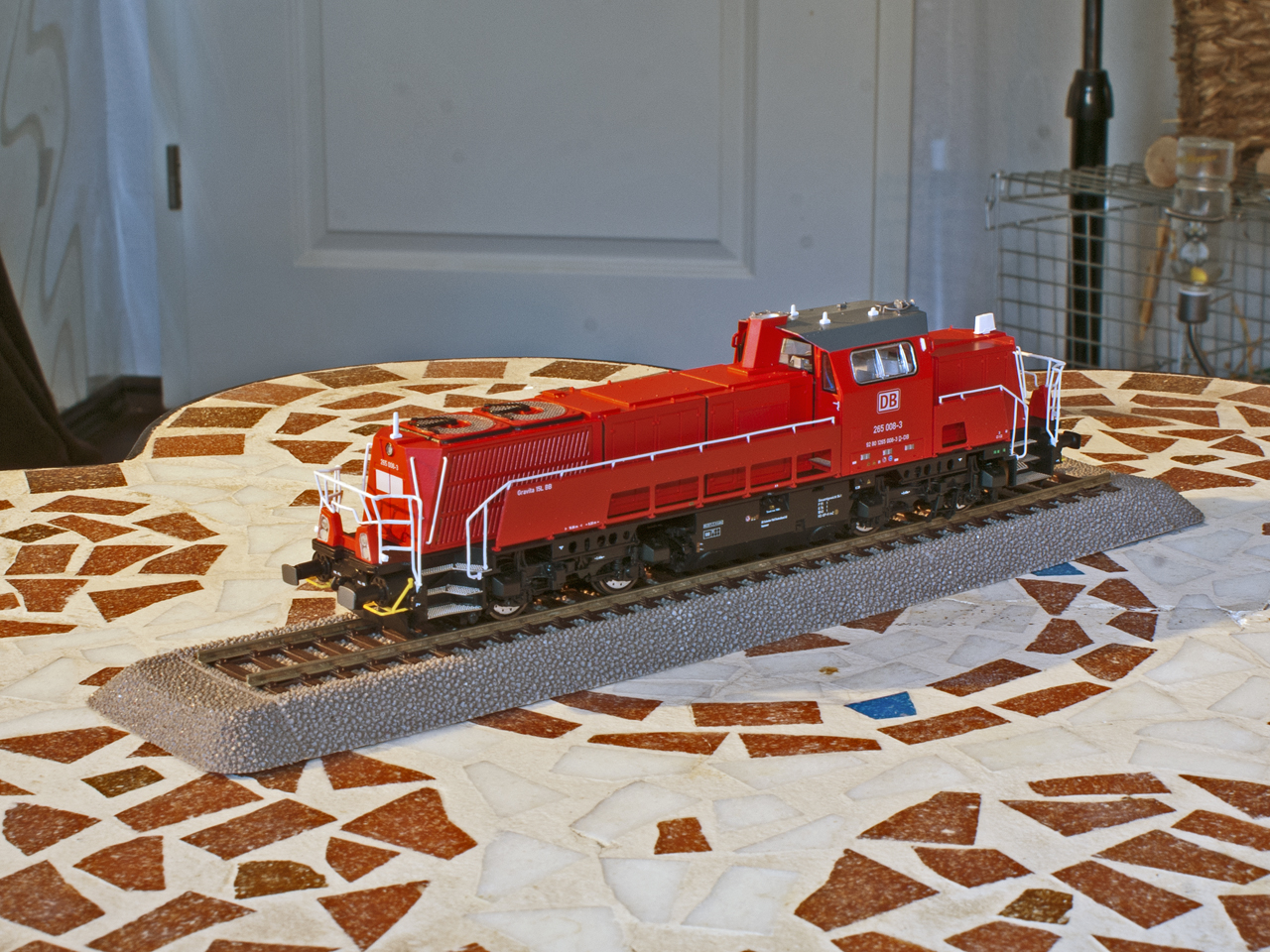
Especially since it is a shunter where one might not ordinarily expect any particular regard to appealing design, I do think the Gravita is a rather sharp-looking locomotive – owing, for example, to the long, stretched motor hood, walkway railing and cladding, raked-back engine exhaust pillar and the inward slanted headlight clusters. This peculiar shape has, I think, been rendered rather well by Brawa.
The model represents 265 008, works number L04-18009, which was built in late 2012 and delivered on 3 January, 2013.
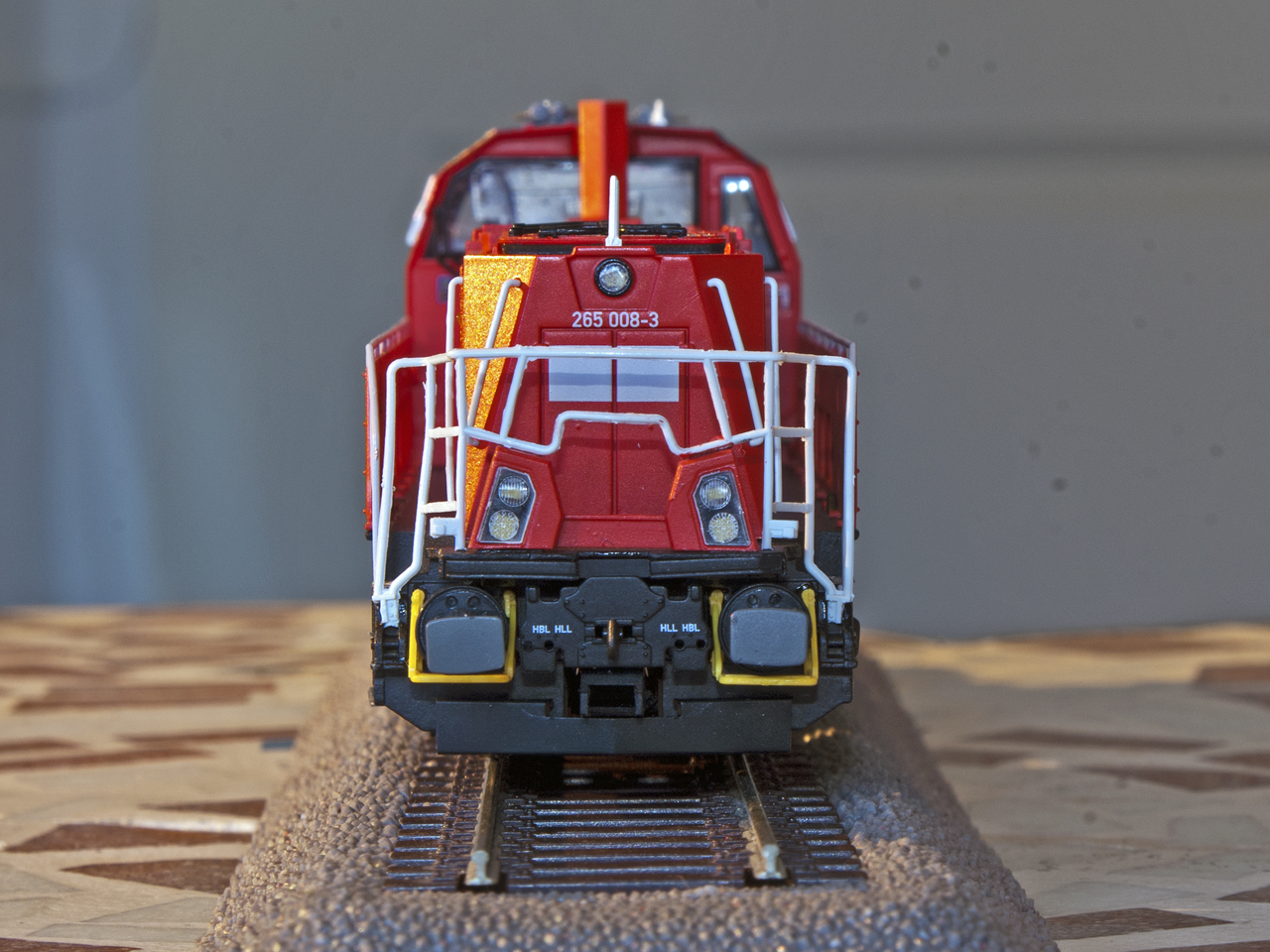
The model also has extension coupler pockets and sprung buffers, whose pads have even been painted a lighter grey to suggest the presence of the usual buffer grease.
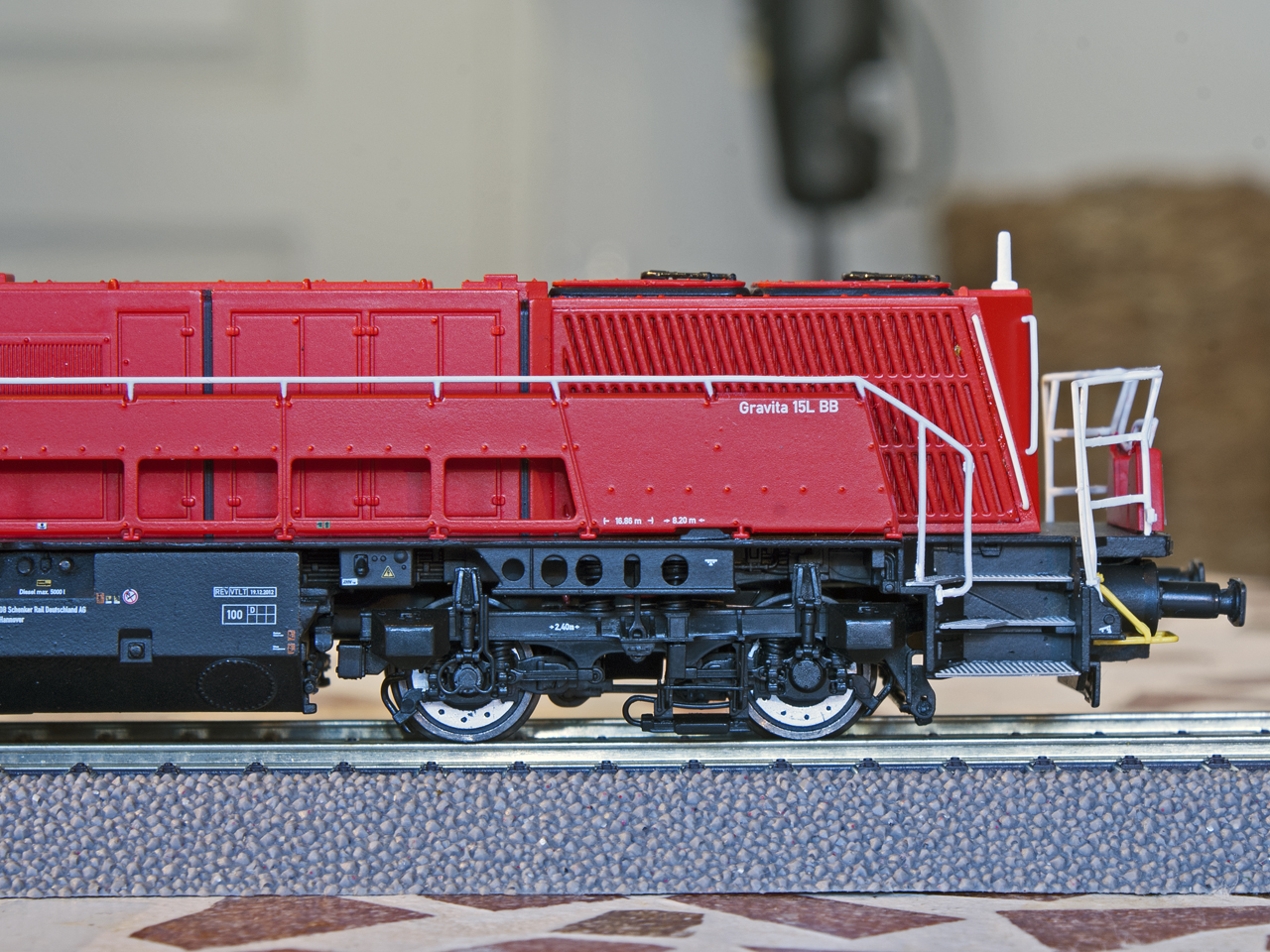
The Brawa model is also painted cleanly and lettered crisply and legibly. Also note the finely detailed bogies.
As per the revision grid on the front end of the fuel tank, 265 008 had its acceptance check completed at the Voith locomotive works (VTLT, which is not an official abbreviation from the National Register of Railway Facilities) on 19 December, 2012. You can also read that the locomotive is allocated to the Hanover branch office of DB Schenker.
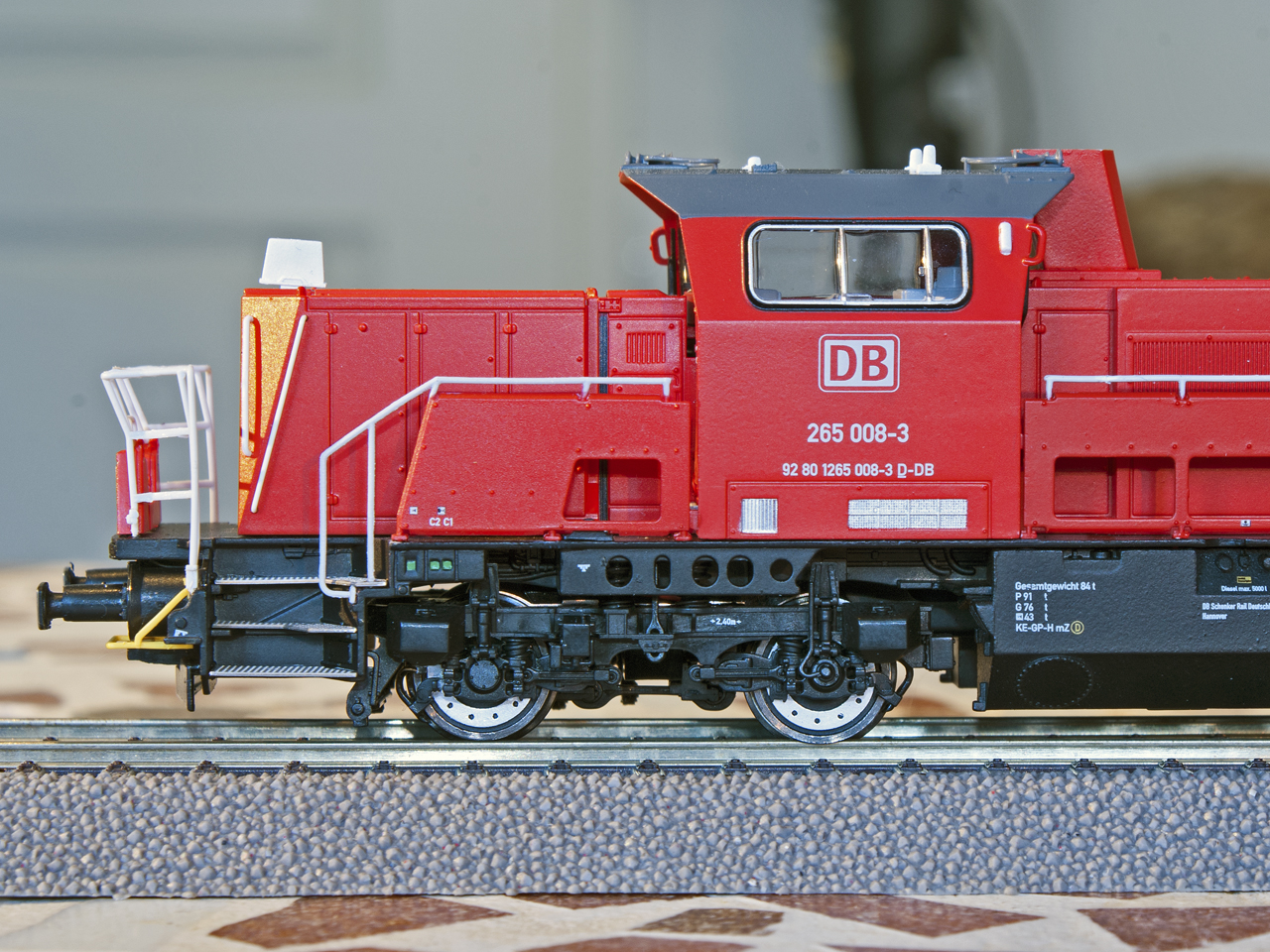
It is also worth noting that in the National Vehicle register, the Gravita 15L BB is listed as class 1265, which in this case corresponds with Deutsche Bahn's internal class designation of 265. However, with the EVN-formatted running numbers having mandatory four-digit class numbers, designations given to future locomotive types do not necessarily have to match the structure of Deutsche Bahn's traditional numbering scheme.
You can also read the braking weights table:
P 91 tonnes
G 76 tonnes
Parking brake 43 tonnes
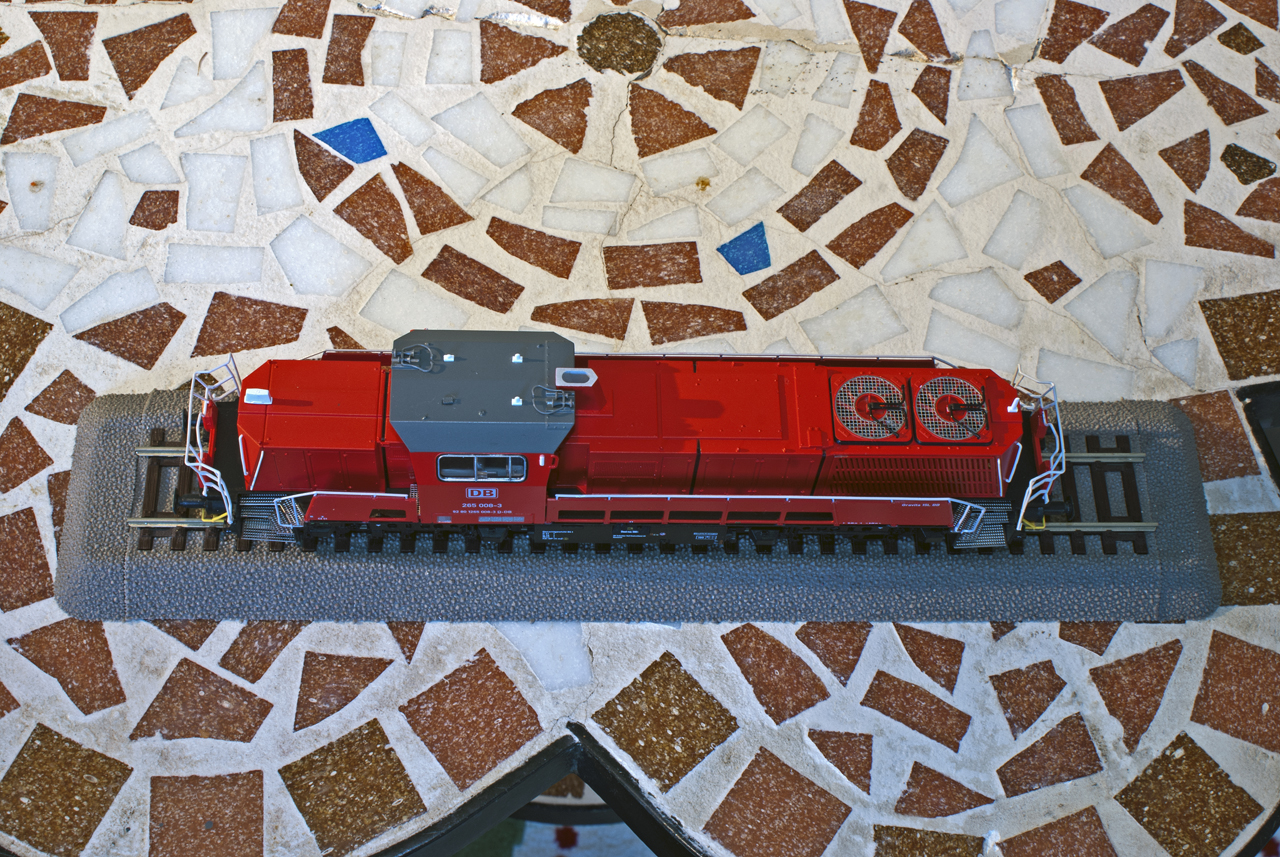
While there usually isn't all that much to be seen on a diesel locomotive's topsides, I do think the Gravita is worth taking a top-down look. Note the various radio communications and remote control antennas on the cab roof and on both hoods, as well as the horns with finely modelled air conduits. The cooling fans are properly concealed by photo-etched grilles.

In my impression, Brawa's design engineers clearly took cues from Saechsische Waggonfabrik as far as underfloor details are concerned! Note the distinct wheelset gearboxes, brake callipers, sand tubes, and faux traction bar attachment bearings.
To conclude this posting, let me just link a few Youtube videos about Gravita locomotives:
Thank you for reading!
-
 5
5




4 Comments
Recommended Comments
Create an account or sign in to comment
You need to be a member in order to leave a comment
Create an account
Sign up for a new account in our community. It's easy!
Register a new accountSign in
Already have an account? Sign in here.
Sign In Now